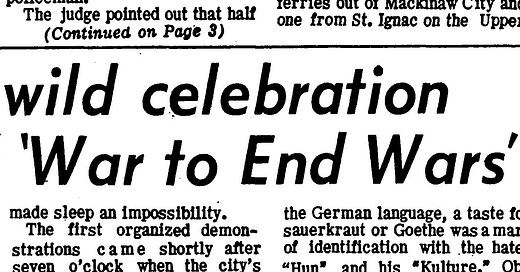"City had wild celebration At end of 'War to End Wars'" from the November 12, 1968 Door County Advocate
By STANLEY GREENE
City had wild celebration At end of 'War to End Wars'
By STANLEY GREENE
It was just 50 years ago that Sturgeon Bay, along with most of the world, jubilantly celebrated the signing of the armistice, ending not only World War I but, it was hoped, all wars to come. By proclamation of the president and by congressional action, November 11th was officially set aside to be celebrated each year as "Armistice Day.' But passing years and wars dulled its significance. In 1954, in keeping with the times November llth became "Veteran's Day" and instead of using the day to celebrate the ending of a single war, we now use it to pay tribute to the American soldier who must bear the brunt of an accelerating series of wars.
But those whose memories run back to the first "Armistice Day," 50 years ago, will recall that it had a particular savor of its own. We thought that we stood on the threshold of a new era that would dispense with war as an instrument of national policy and that expectant faith gave it a quality that will always be remembered.
The news of the great event arrived in Sturgeon Bay at half past three in the morning, Monday, November 11th, 1918, by telegraph. The community was fast asleep but the irrepressible editor of the Door County News, Earl "Mitch" LaPlante soon had it awake.
Perched on the swaying, back seat of an open car, he careened around the city streets with honking horn and booming megaphone. It was an ungodly noise in the still dark hours of the morning but even a second visit was sometimes necessary to rouse a street. Within twenty minutes, the Pied Piper of Victory had acquired a growing crowd who, with cow bells, whistles, dishpans, and straining vocal cords made sleep an impossibility.
The first organized demonstrations came shortly after seven o'clock when the city's four hundred shipyard workers assembled at Smith's and at the Universal yards and began to parade with banners and music. By now the whistles were hooting and the church bells ringing. All over the city, people were pouring into the streets, laughing and cheering, shaking bands, parading and dispersing to form another parade.
One of the constant features of past war demonstrations was brought out for the last time-an effigy of "Kaiser Bill." Exhibited in a hearse, hung from various telephone poles, riddled with bullets by the Home Guard unit, it was finally consumed for the last time in a huge bonfire on the market square.
It was not until seven thirty in the evening that Mayor E. S. Minor was able to channel the spontaneous popular celebration into official channels with all the trimmings, including speeches and refreshments and a huge bonfire into which "Kaiser Bill" was heaved.
Not since the close of the Civil War had the community ever experienced such an emotional upheaval.
It was the celebration not only of the end of a war but of the end of all wars, of a world made safe for democracy and free from despots. But it was also a celebration in relief at the lifting of an intolerable burden from the community.
Part of that burden had been the product of the irritations and frustrations of war time rationing and the restrictions and impositions decreed by sometimes over-zealous, amateur bureaucrats. Part of it was the result of the campaign of hate and intimidation directed against its German community. The use of the German language, a taste for sauerkraut or Goethe was a mark of identification with the hated "Hun" and his "Kulture."
Objectors to the defilement of their racial and cultural origins could, at the worst, expect manhandling and at the best, to be hated before a court as an enemy subversive and fined for opposing the war effort.
But the most substantial part of the burden was the fear of death. Since the declaration of war in 1917, all males between the ages of 18 and 45 had been placed on the draft lists. Of these the local draft board had inducted about 430 persons and about 160 more had volunteered. Every issue of the local papers contained a new list of casualties that eventually came to account for almost one out of every four of the boys in service. It was estimated that one out of every six men in the first contingent that left in August of 1917 had died of disease or enemy action.
The ironic thing about that first 'Armistice Day' was that the community, in celebrating the cessation of death on the battlefield brought upon itself a devastation as great as its battlefield casualties.
The dread "influenza" had been striking surrounding areas. Shortly before the Armistice celebration, Dr. Sibree, Sturgeon Bay's health officer, had announced, while there was no indication that the "flu" had invaded the city, in view of the threat of a possible epidemic, he ordered the closing of schools and churches and forbade public assemblies indoors and out.
In the wild enthusiasm of the Armistice celebration Dr. Sibree's orders and the threat of the "flu" were forgotten but in the weeks to come the epidemic it provoked proved almost as devastating to its citizens as the war had to its soldiers.
Courtesy of the Door County Library Newspaper Archive
Articles by Stanley Greene



